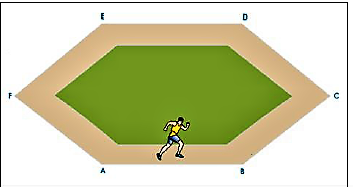In the example discussed under the topic uniform and non-uniform motion we have classified motion along circular track as an example of non-uniform motion. Let us now see why circular motion is considered as non-uniform motion. The figure shows an athlete running with uniform speed on a hexagonal track.

Athlete Running on a Regular Hexagonal Track
The athlete runs with uniform speed along the segments AB, BC, CD, DE, EF and FA of the track and at the turns he quickly changes his direction of motion to stay on the track, without changing his speed. Similarly if the track was a regular octagon the athlete would have changed the direction of motion eight times to remain on the track.

As the number of sides of the track increases, the athlete has to turn more often. Now if we increase the number of sides indefinitely the shape of the track will approach the shape of a circle. Therefore, a circle can be considered as a polygon with infinite sides and hence motion along a circular path is classified as non-uniform motion.

Thus, an object moving along a circular track with uniform speed is an example for a non - uniform motion because the direction of motion of the object goes on changing at every instant of time.